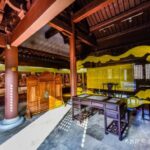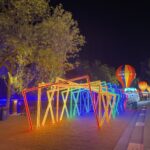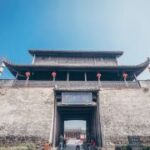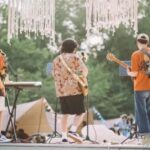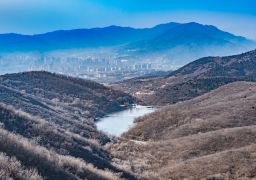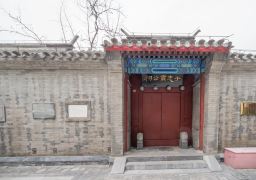Tongbo Mountain Scenic Area covers an area of 320 square kilometers, accounting for approximately one-fourth of Guangfeng. The natural ecological environment is well-preserved, with 30,000 acres of virgin forests, a forest coverage rate of over 98%, and a timber volume of 1.2 million cubic meters. It boasts 100,000 acres of bamboo forests and is home to a vast area of the nationally valuable and rare tree, the Chinese yew.
Abundant rare wildlife and flora thrive here, along with various underground mineral resources. Within its boundaries, there are three high gorge lakes: QiXing, JunTan, and TiaoPu, each with shimmering waters and breathtaking scenery. The area also features historical military passes and scenic spots such as MuChengGuan, ZhiMianGuan, WuGuanTong, TiaoPuGuan, and TaiPingGuan.
Scattered throughout are peculiar peaks and rocks, beautiful mountains, and clear waters, with attractions such as Tongbo Mountain Peak, QiXing Peak, ShuangFeng Peak, WuDao Peak, ShangJia Peak, JunTan Stone, Old Man Stone, GuanYu Stone, and the Eight Immortals Playing Chess, which captivate visitors.
Tongbo Mountain also has a rich cultural heritage, including the provincially protected JiuXian Mountain Fortress and the former residence of Zhang Shuye, a Northern Song dynasty general and scholar. BaiHua Rock, one of Guangfeng’s ‘Three Rocks,’ houses the GuangFu Temple, which dates back to the Yuan dynasty. Inside, there are twenty-four stone murals depicting various deities, each with unique expressions and lively forms. From this vantage point, one can overlook the provinces of Jiangxi, Zhejiang, and Fujian.
The scenic area also includes the renowned GuangFu Temple, WuDao Peak Temple, and Lady Ma’s Temple. There’s the site of the 1931 Guangfeng Soviet Government and the Red Army Rock, where eighteen brave soldiers leaped to their deaths, symbolizing the ‘Red Homeland.’
Tongbo Mountain, part of the Wuyi Mountain Range, is the highest peak in Guangfeng County, with an elevation of 1,534.6 meters. The summit is covered with grasses, providing a flat area with a temperature difference of less than 15 degrees Celsius from the ground in summer, making it an ideal retreat for vacation and summer escape. The area is lush with ancient trees, deep valleys, and a well-preserved natural ecological environment. The forest coverage rate is as high as 90%, with a timber volume of 1.2 million cubic meters, including more than 30,000 acres of secondary virgin forests and over 100,000 acres of bamboo forests. Over 100 families and more than 2,000 species of wild higher plants are distributed here, including nationally and provincially protected rare and endangered plants such as Southern Chinese yew, Chinese torreya, camphor tree, willow pine, ginkgo, magnolia, and lotus tree.
Amidst the vast bamboo forests, hundreds of extremely precious natural young Southern Chinese yew trees can be found. Additionally, there are very rare ginkgo and lotus tree species, mostly planted during the Qing dynasty, with a history of one to two hundred years. According to surveys, there are more than 200 species of birds and mammals, over 100 species of amphibians and reptiles, and a multitude of insect species, including more than 30 species of nationally and provincially protected wildlife such as the Yellow-bellied Tragopan, Tufted Deer, Short-tailed Monkey, Clouded Leopard, Pangolin, Bear, Hook-nosed Turtle, Sharp-snouted Snake, and King Cobra.
Affected by the eroded structural terrain, Tongboshan has formed steep peaks one after another, with various postures and vividness, constituting a series of lifelike natural landscapes. Baihua Rock, also known as Baihua Yan, is located among the lofty mountains of Songshan in Gaoyang Village in the northeast of Tongboshan. It is one of the ‘three rocks’ in Guangfeng County. The area of the cave is about 2500 square meters, and the rock is 60 meters high. Looking from afar, it is like a blooming petal. There is Guangfu Temple in the rock. It was built in the late Tang Dynasty. There are murals of twenty-four immortals of the Yuan Dynasty on the stone wall in the temple. The figures have different expressions and vivid shapes.
Recommended Routes
1. One-day Tour of Tongboshan
Morning: Guangfeng – Jiuxian Lake (take a cruise ship) – Alpine Taxus chinensis scenic area – Lunch in Lingdi
Afternoon: Lingdi – Baihua Rock – Jiuxian Mountain – Guangfeng
2. Two-day Tour of Tongboshan
First day morning: Guangfeng – Jiuxian Lake (climb Guishou Peak, take a cruise ship, pay respects to Red Army Rock, etc.) – Baihua Rock – Lunch in Lingdi (prepare dry food for noon the next day)
First day afternoon: Lingdi – Alpine Taxus chinensis scenic area – Dafengyuan Forest Farm for dinner
Second day: Dafengyuan Forest Farm – primeval forest – Return to Guangfeng
3. Three-day Tour of Tongboshan
First day: Guangfeng – Jiuxian Mountain (have farmhouse meal in Gaoyang) – Baihua Rock – Tianxing Gate – Gaozhuang – Dafengyuan Forest Farm for dinner and accommodation.
Second day: Dafengyuan Forest Farm – primeval forest – Return to Dafengyuan Forest Farm for dinner and accommodation.
Third day: Dafengyuan Forest Farm – Alpine Taxus chinensis scenic area – Lunch in Lingdi – Jiuxian Lake (climb Guishou Peak, take a cruise ship, pay respects to Red Army Rock, etc.) – The journey ends successfully.
Opening hours: Open all year round from 09:00 to 17:00.
Preferential policies: Children: Under 1.2 meters (excluding) in height, free; 1.2 meters (inclusive) to 1.5 meters (inclusive) in height, discounted.
Tongbo Mountain Scenic Area
Tongbo Mountain Scenic Area covers an area of 320 square kilometers, accounting for approximately on[...]
